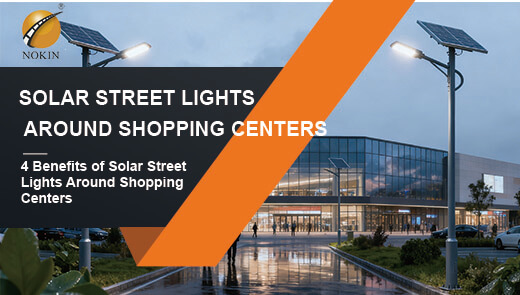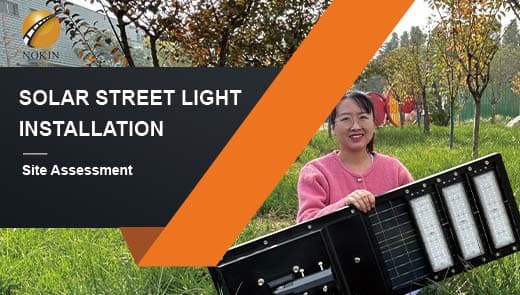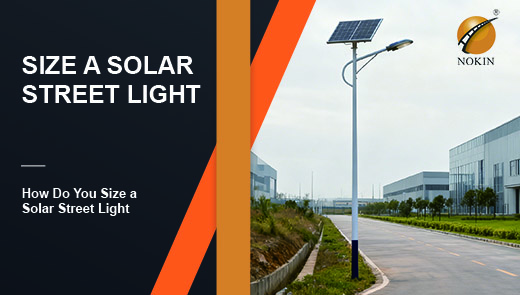4 Benefits of Solar Street Lights Around Shopping Centers
In an era where consumption upgrades and environmental awareness are deeply intertwined, the surrounding environment experience of shopping centers has become a key factor influencing foot traffic. Solar street lights, as a lighting solution that combines practicality with sustainability, are gradually replacing traditional street lights, bringing multiple benefits to shopping centers: safety, aesthetics, economy, and environmental friendliness. This article will analyze why solar street lights have become the preferred lighting solution for modern shopping centers, focusing on four core advantages.
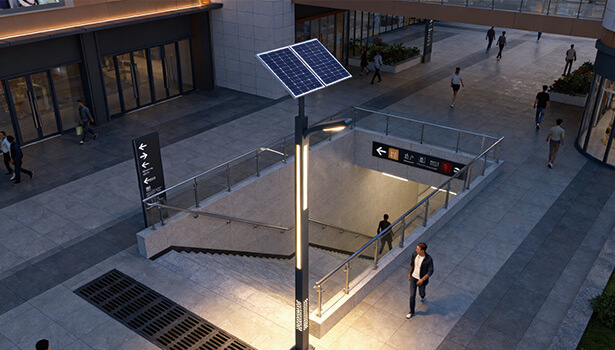
Solar Street Lights Improve Security
Eliminate Lighting Blind Spots, Reduce Accident Risks
Areas surrounding shopping centers—such as parking lots, pedestrian walkways, and entrances—often suffer from inadequate nighttime lighting, creating safety hazards. Solar street lights utilize high-efficiency LED sources that provide uniform illumination, effectively eliminating dark blind spots. Their built-in lithium batteries store sufficient energy to ensure continuous lighting even during cloudy or rainy days, avoiding the illumination interruptions caused by power outages or circuit failures in traditional lights. This significantly reduces the incidence of accidents like customer slips, trips, and collisions.
Deterring Illegal Activities and Enhancing Safety Perception
Adequate lighting serves as an effective deterrent against theft, vandalism, and other unlawful acts. The high brightness of solar street lights renders the surroundings of shopping centers clearly visible, leaving no hiding places for criminals and reducing the likelihood of crime at its source.
According to relevant statistics, commercial areas equipped with solar street lights for nighttime illumination have seen an average reduction of over 30% in property-related crime rates. For customers, well-lit surroundings enhance safety during outings, thereby increasing trust in the shopping center. For businesses, a secure operating environment is also a crucial prerequisite for ensuring normal store operations.
Solar Street Lights Beautify the Nighttime Atmosphere
Soft Illumination
Traditional street lights often suffer from glaring light and uneven brightness, affecting the comfort of nighttime shopping. Solar street lights can adjust brightness according to the scene, emitting soft, non-glaring light that creates a warm and pleasant nighttime ambiance. Whether customers are strolling after dinner, leisurely shopping, or heading home after a gathering with friends, the gentle illumination makes the entire experience more enjoyable. This extends the time customers spend around the mall, indirectly driving consumption.
Aligning with Commercial Aesthetics
Modern solar street light designs emphasize the fusion of aesthetics and functionality, offering diverse styles including minimalist modern, vintage elegance, and creative individuality. Shopping centers can select compatible light fixtures based on their architectural style and thematic positioning, integrating the lights as part of the surrounding landscape.
For instance, high-end shopping centers may opt for sleek, minimalist designs to highlight sophistication. Theme-based shopping centers can pair with uniquely shaped creative lights to reinforce their thematic ambiance. When street lights harmonize with the mall's architecture and greenery, they significantly elevate the shopping center's overall visual appeal, creating a distinctive commercial environment.
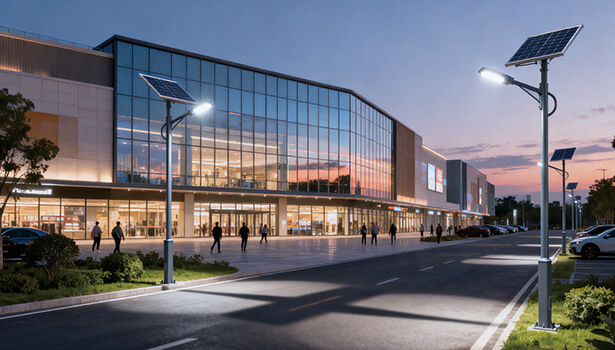
Solar Street Lights Are Cost-Effective
Initial Investment Comparison
In the initial investment phase, solar street lights have relatively higher fixture purchase costs due to core components like solar panels and lithium batteries. Traditional grid-connected street lights have lower fixture costs, covering only the luminaire itself.
However, solar street lights eliminate the need for complex cable laying and road excavation, featuring a simplified installation process that reduces costs by 30% to 40% compared to traditional options. Traditional grid-connected lights require specialized teams to excavate roads, lay cables, and debug circuits. This not only extends construction timelines but also disrupts surrounding traffic and landscapes, incurring additional coordination expenses.
Operating Cost Comparison
Regarding electricity expenses, solar street lights rely entirely on solar power generation without requiring grid connection, resulting in zero electricity costs throughout their entire service life. Traditional grid-connected street lights depend on municipal power supply. For large-scale shopping centers, electricity expenses accumulate into a significant long-term expenditure.
Maintenance costs: Solar street lights feature long-lasting core components with a lifespan of 10-15 years. Their simple structure and low failure rate result in minimal annual maintenance expenses, primarily involving routine tasks like cleaning solar panels and inspecting lithium batteries. In contrast, traditional grid-connected lights have shorter bulb lifespans (5-8 years), and their underground cables are prone to aging and damage, necessitating frequent replacements and repairs. Consequently, their ongoing maintenance costs far exceed those of solar street lights.
Payback Period
Although solar street lights have a slightly higher initial purchase cost, the combined savings from installation costs, electricity bills, and maintenance fees typically result in a payback period of just 2-3 years. For a typical-sized shopping mall, installing solar street lights yields substantial annual savings in electricity and maintenance costs. After deducting the initial additional investment, the extra expenditure can be recouped in as little as 2 years, followed by years of sustained cost advantages with zero electricity bills and low maintenance.
Furthermore, many local governments offer subsidies or tax incentives to commercial entities installing solar lighting systems to promote renewable energy, further reducing the initial investment burden for shopping centers and shortening the payback period.

Solar Street Lights Are Sustainable
Reducing Carbon Emissions
Powered by solar energy, solar street lights eliminate the need for fossil fuels like coal or oil, making them a zero-emission, pollution-free green lighting solution.
Each solar street light reduces approximately 1 ton of carbon dioxide emissions annually. Installing a sufficient number of these lights across a shopping center yields substantial annual carbon savings—equivalent to the carbon sequestration capacity of hundreds of mature trees. Under global carbon neutrality goals, solar street lights effectively lower shopping centers' carbon footprints, contributing to environmental conservation.
Enhancing Brand Image
Today's consumers increasingly favor environmentally conscious brands. Installing solar street lights in shopping centers not only embodies sustainable development principles but also demonstrates corporate social responsibility.
Such eco-friendly initiatives earn consumer goodwill and recognition, particularly attracting environmentally conscious younger demographics. Surveys indicate that 70% of consumers prefer shopping at venues with prominent environmental values. By adopting solar street lights, shopping centers can establish a green and responsible brand image, enhance brand competitiveness, and achieve a win-win outcome for both commercial and social value.
From ensuring safety and beautifying the environment to reducing costs and practicing environmental stewardship, solar street lights deliver multidimensional value enhancement for shopping centers. In today's intensifying commercial competition, choosing solar street lights represents not only an upgrade in lighting solutions but also a strategic decision to optimize operations and elevate brand influence.
As solar technology continues to advance, the performance of solar street lights will further improve while costs steadily decrease. It is anticipated that solar street lights will become standard equipment for more shopping centers in the future, injecting green energy into commercial lighting and illuminating the path toward sustainable development for these retail hubs.

